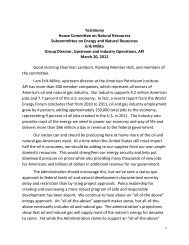Mr. Clint Georg - The House Committee on Natural Resources ...
Mr. Clint Georg - The House Committee on Natural Resources ...
Mr. Clint Georg - The House Committee on Natural Resources ...
Create successful ePaper yourself
Turn your PDF publications into a flip-book with our unique Google optimized e-Paper software.
will eventually die. Removing these trees has often meant that the property owner (including the USFS)has paid to have the trees removed.<str<strong>on</strong>g>The</str<strong>on</strong>g> most cost effective removal of these trees, and the <strong>on</strong>ly practical method <strong>on</strong> a large scale, is to havea commercially viable means of harvesting and selling the timber. <str<strong>on</strong>g>The</str<strong>on</strong>g>re have been a number of articlesin the media highlighting various companies trying to make use of the beetle killed timber includingcompanies making wood flooring, furniture, log cabins and heating fuel. <str<strong>on</strong>g>The</str<strong>on</strong>g>re has also been, in <strong>on</strong>ecase, $76 milli<strong>on</strong> of federal grant m<strong>on</strong>ey invested in trying to use wood chips from beetle killed trees asa source for cellulosic ethanol that would break America's "addicti<strong>on</strong> to oil”. Unfortunately the ethanolexperiment failed without solving the issue of how to operate <strong>on</strong> a commercially viable scale and all theother commercial efforts in the state for timber usage <strong>on</strong>ly equal a fracti<strong>on</strong> of the capacity of either theM<strong>on</strong>trose or Saratoga sawmills.<str<strong>on</strong>g>The</str<strong>on</strong>g> USFS, facing a dwindling commercial timber industry and needing to remove vegetati<strong>on</strong> andperform other activities to promote healthy forest stands, reduce fire hazards, or achieve other landmanagement objectives, was granted authority in 2003 to issue Stewardship c<strong>on</strong>tracts for forestmanagement. This authority, which expires in 2013, is being used by the USFS in Colorado andWyoming to pay private companies to provide forest management and remove infected trees fromcritical areas.One of the benefits of stewardship c<strong>on</strong>tracting is that some of the cost of treatment is offset with thevalue of the logs removed in the course of the work. Having an outlet for these logs increases the valueof the logs and will ultimately reduce the USFS Stewardship c<strong>on</strong>tracting costs. Currently, the largestinsect infestati<strong>on</strong>s are in Northern Colorado, a relatively l<strong>on</strong>g distance from the sawmill in M<strong>on</strong>trose.Once the Saratoga sawmill is operating, the value of the logs in this area will increase and the USFS willbe able to pay less for Stewardship c<strong>on</strong>tracts.<str<strong>on</strong>g>The</str<strong>on</strong>g> M<strong>on</strong>trose mill and the Saratoga mill are each capable of processing 40 MMBF of timber annually <strong>on</strong>a single shift. Operating at multiple shifts, these two large sawmills will <strong>on</strong>ly harvest a small porti<strong>on</strong> ofthe Colorado forests – even operating <strong>on</strong> two shifts, a sawmill of this size would take more than athousand years to treat all the timber in Colorado – but these sawmills offer the <strong>on</strong>ly large scale methodof processing timber and they do so while paying for the timber. This benefits the USFS both directlythrough revenues from timber sales and indirectly through the reduced cost of stewardship c<strong>on</strong>tracts inthe area. In all, these sawmills provide a cost effective means of removing infected trees in theColorado and Wyoming regi<strong>on</strong>.Colorado Spruce and P<strong>on</strong>derosa Pine ForestsIt must be noted that although the mountain pine beetle c<strong>on</strong>tinues to be Colorado’s most damagingforest pest, this is not the <strong>on</strong>ly significant threat to Colorado’s forests. <str<strong>on</strong>g>The</str<strong>on</strong>g> same beetle is alsoattacking an increasing amount of p<strong>on</strong>derosa pine forests; 275,000 acres in 2011 al<strong>on</strong>e. Also, thespruce bark beetle, the sec<strong>on</strong>d greatest insect threat to the state, is causing extensive mortality inColorado’s spruce forests and as of 2011 had already infested 262,000 acres of Engleman Spruce.C<strong>on</strong>trolling the impact of these infestati<strong>on</strong>s, similar to lodgepole pine infestati<strong>on</strong>s, requires removal ofthe timber and emphasizes the importance of an active sawmill industry servicing the state.POINT NO. 3: LARGE SAWMILL OPERATIONS PROVIDE A COST EFFECTIVE MEANS OF TIMBERMANAGEMENT THAT IS NOT MATCHED BY OTHER COMMERCIALLY VIABLE OPTIONS.7
















